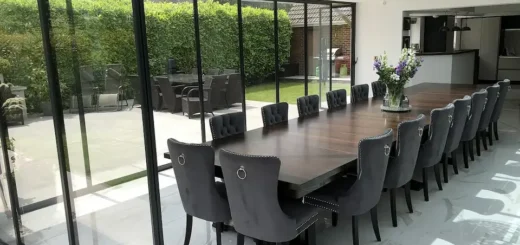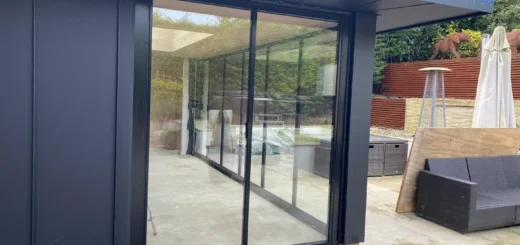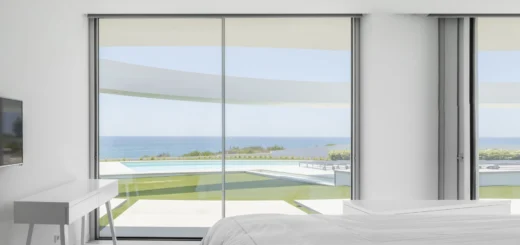Aluminium Concertina Doors Guide: Materials, Design & More
Table of Contents
What Are Aluminium Concertina Doors
Concertina doors, also known as accordion glass doors or bifold doors, fold back in sections to create wide openings between spaces. Modern aluminium concertina doors combine robust frames with large glass panels, making them popular for kitchens, living spaces and garden rooms.
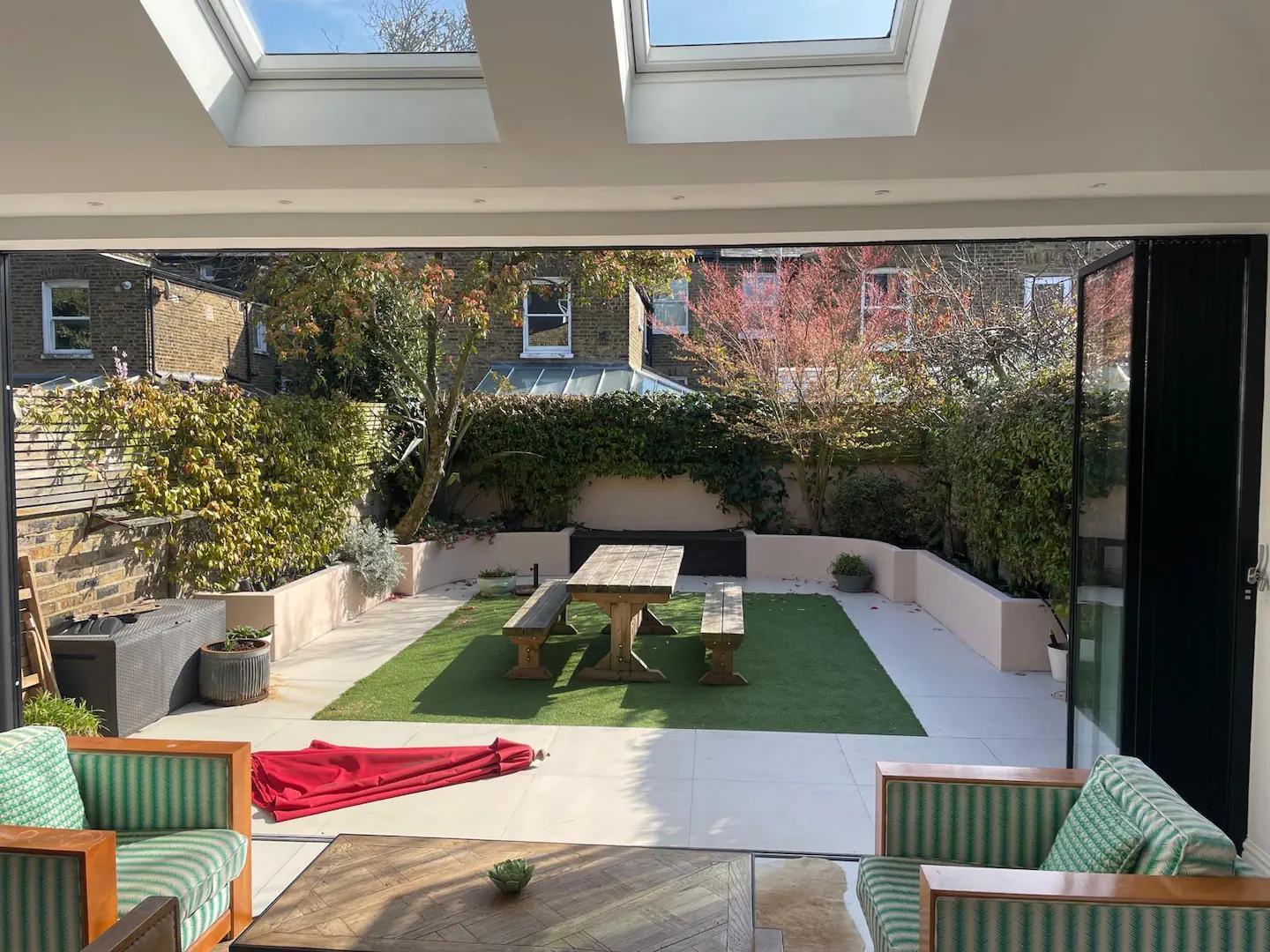
How Concertina Door Systems Work
Concertina doors run smoothly along top-mounted tracks, with the weight distributed through rolling mechanisms and bottom guides. Multiple door panels fold and stack against each other when opened, sitting flat against the wall or jutting out at right angles depending on the configuration chosen.
Running gear mounted in the track system carries most of the door weight, while bottom guides keep the panels aligned. Aluminium concertina doors use precision-engineered wheels and runners, paired with multipoint locking systems that secure the doors at multiple points along the frame.
Key Terms to Know
- Bottom Guide: Track system at the floor level that helps align door panels
- Cill: The bottom part of the frame that sits on the floor
- Flush Threshold: A low-profile or level threshold between inside and outside
- Gaskets: Rubber seals between frame and glass
- Multipoint Lock: Security system that locks at several points
- Powder Coating: Powder coated aluminium doors are doors with a tough paint finish applied electrostatically
- Sightlines: Visible frame width when doors are closed
- Thermal Break: Insulating barrier within aluminium frames
- Top Track: Overhead rail system carrying door weight
- Weather Seals: Protective strips preventing drafts and water ingress
Aluminium Door Profiles
Modern aluminium concertina doors use thermally broken profiles – frames with a polyamide barrier between inner and outer sections. Frame depths range from medium to deep, with deeper profiles offering improved thermal performance. Manufacturers design their profiles to balance slim sightlines with the strength needed to support large glass panels.
The main frame components include outer frames, door leaves, meeting stiles, and threshold options. Aluminium concertina glass doors require careful profile selection based on panel sizes, desired thermal performance, and local weather conditions. Profile design determines both practical performance and visual appeal, from the width of visible frames to how well the doors keep out wind and rain.
Technical Features of Aluminium Concertina Doors
Modern aluminium concertina doors combine advanced materials with precise manufacturing methods to create robust, well-insulated door systems. The technical aspects of these doors determine their performance in real-world conditions.
Thermal Breaks
Polyamide strips placed between the inner and outer sections of aluminium frames stop cold from passing through the metal. These thermal barriers measure between 28mm and 42mm in width, preventing heat loss and condensation build-up around the frames. External concertina doors made without proper thermal breaks can create cold spots and waste energy.
The thermal break design varies among manufacturers, with some using multiple barriers for improved insulation. Premium aluminium concertina doors often feature deeper thermal breaks combined with specialised gaskets and weather-resistant seals, resulting in better thermal values and reduced energy bills.
Weight and Support Requirements
The strength-to-weight ratio of aluminium allows for larger glass panels while keeping the overall structure lightweight. Aluminium concertina glass doors can span greater widths than other materials, with some configurations reaching up to seven metres. Each panel requires careful calculations to ensure the frame and hardware can manage the load properly.
Top-hung systems distribute weight through the head frame and into the building structure above. The track system uses precision bearings and wheels rated for specific loads, while bottom guides keep panels aligned without carrying significant weight. Aluminium concertina doors need proper structural support – especially above the opening where the track system fixes to the building.
Support posts might be needed for wider openings, particularly in older properties where the original structure wasn’t designed for large glass doors. The exact requirements depend on factors like opening width, panel configuration, and the building’s existing support structure.
Hardware and Security Features
High-grade stainless steel hinges connect door panels, allowing smooth operation while supporting substantial weights. The hardware includes anti-lift mechanisms and multi-point locks that secure the doors at several points along the frame height. Shoot bolts in the top and bottom of the panels provide additional security when the doors are closed.
Handle designs range from simple D-handles to magnetic catches that hold panels together when folded. Premium systems often include soft-close mechanisms to prevent slamming, while intermediate handles on wider sets make operation easier. The best hardware resists corrosion and maintains smooth operation even after years of use.
Many manufacturers now offer advanced locking systems with multiple security features built into a single unit. These include anti-snap cylinders, hook locks, and reinforced strike plates. The frames themselves include internal strengthening bars that resist forced entry attempts while maintaining slim visible profiles.
Aluminium vs uPVC Concertina Doors
Material choice shapes every aspect of how folding doors perform over their lifespan. While uPVC might seem cost-effective initially, aluminium concertina doors offer superior strength, durability, and visual appeal.
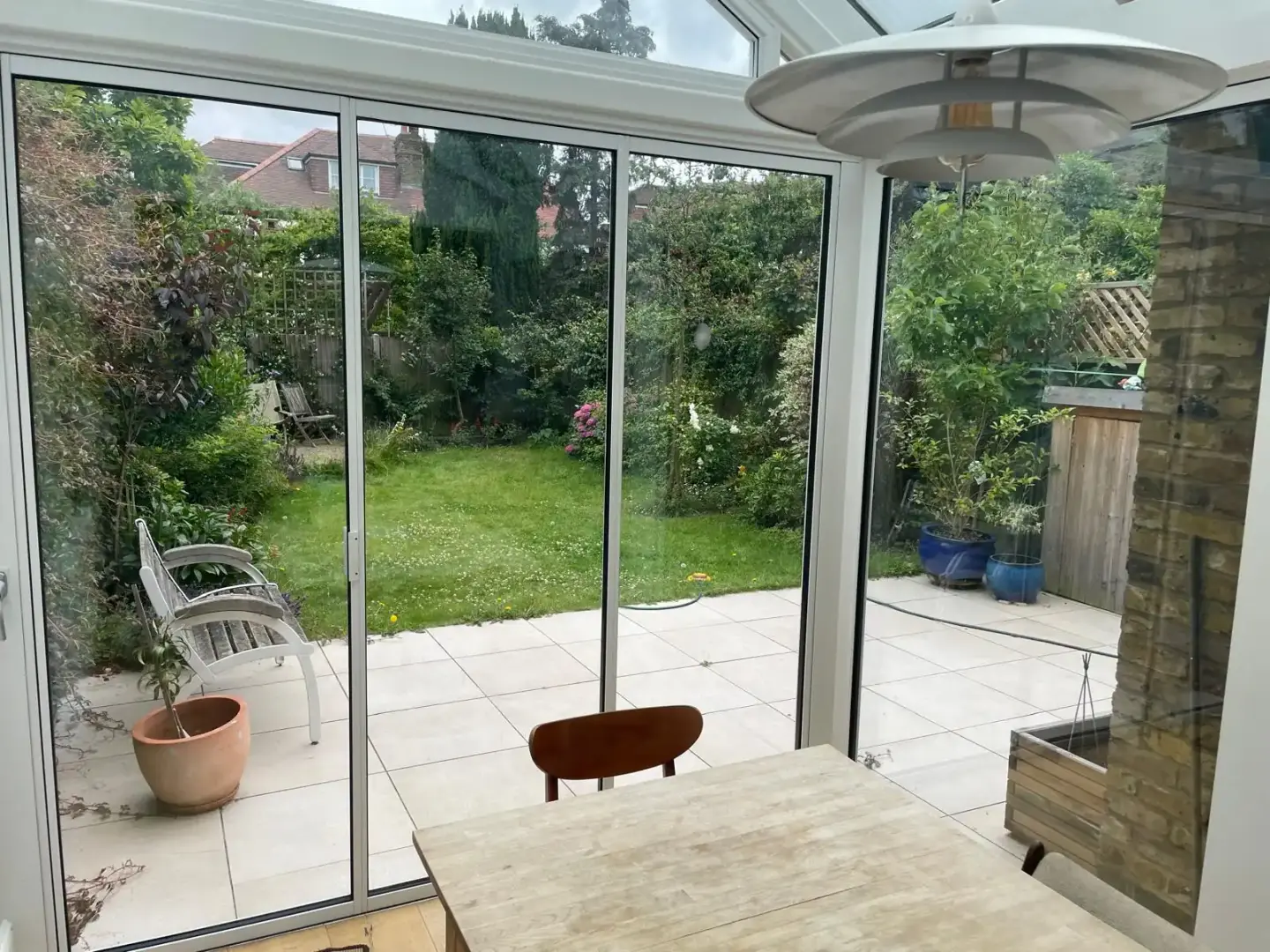
Frame Strength Comparison
The inherent strength of aluminium allows for much slimmer frames than uPVC, creating larger glass areas and better views. Where uPVC requires thick frames and additional reinforcement, aluminium concertina doors maintain their rigidity with minimal frame bulk.
This strength difference becomes particularly noticeable in wider openings, where uPVC frames must be substantially thicker to prevent warping.
Structural stability remains consistent across different temperatures with aluminium frames. Unlike uPVC, which can expand, contract, or warp in extreme weather, aluminium concertina glass doors maintain smooth operation year-round. The metal’s stability prevents sticking or jamming issues common in plastic frames during summer heat.
Long-term Value
Raw aluminium proves fully recyclable at the end of its life, unlike uPVC which often ends up in landfill. The durability of aluminium frames means they typically last decades longer than plastic alternatives, making them more cost-effective despite higher initial prices.
Manufacturing processes for aluminium concertina doors create precise, clean-lined frames that resist degradation. While uPVC can yellow, fade, or become brittle over time, powder-coated aluminium maintains its appearance with minimal maintenance. The colour stays true without peeling or chipping, requiring only occasional cleaning to keep frames looking new.
Performance Benefits
Professional installers often prefer working with aluminium frames due to their dimensional stability and precise manufacturing tolerances. The material’s strength allows for larger panel sizes – up to around 1.2 metres wide per panel compared to uPVC’s typical 0.75 metre limit. This means fewer frame lines interrupting views and more design flexibility.
Thermal performance used to be uPVC’s main advantage, but modern aluminium frames with thermal breaks now match or exceed plastic alternatives. The superior strength of aluminium allows for larger double or triple glazed units, improving overall insulation values. Advanced thermal break designs prevent heat transfer through the frame while maintaining structural integrity.
Security features benefit from aluminium’s inherent strength. Lock mechanisms anchor more securely in metal frames compared to plastic, while the material itself resists forced entry attempts better than uPVC. The robust nature of aluminium means security features remain effective throughout the product’s lifetime, without the degradation common in plastic frames.
Maintenance requirements differ substantially between materials. While uPVC needs regular adjustment as frames age and settle, aluminium systems typically maintain their original operating smoothness. The metal’s resistance to UV damage, temperature changes, and general wear reduces long-term maintenance costs and preserves operation quality.
Powder Coating and Colours
Powder coating creates durable, attractive finishes on aluminium concertina doors through an electrostatic application process. The powder bonds permanently to the metal surface, forming a tough protective layer that guards against scratches, UV damage, and corrosion.
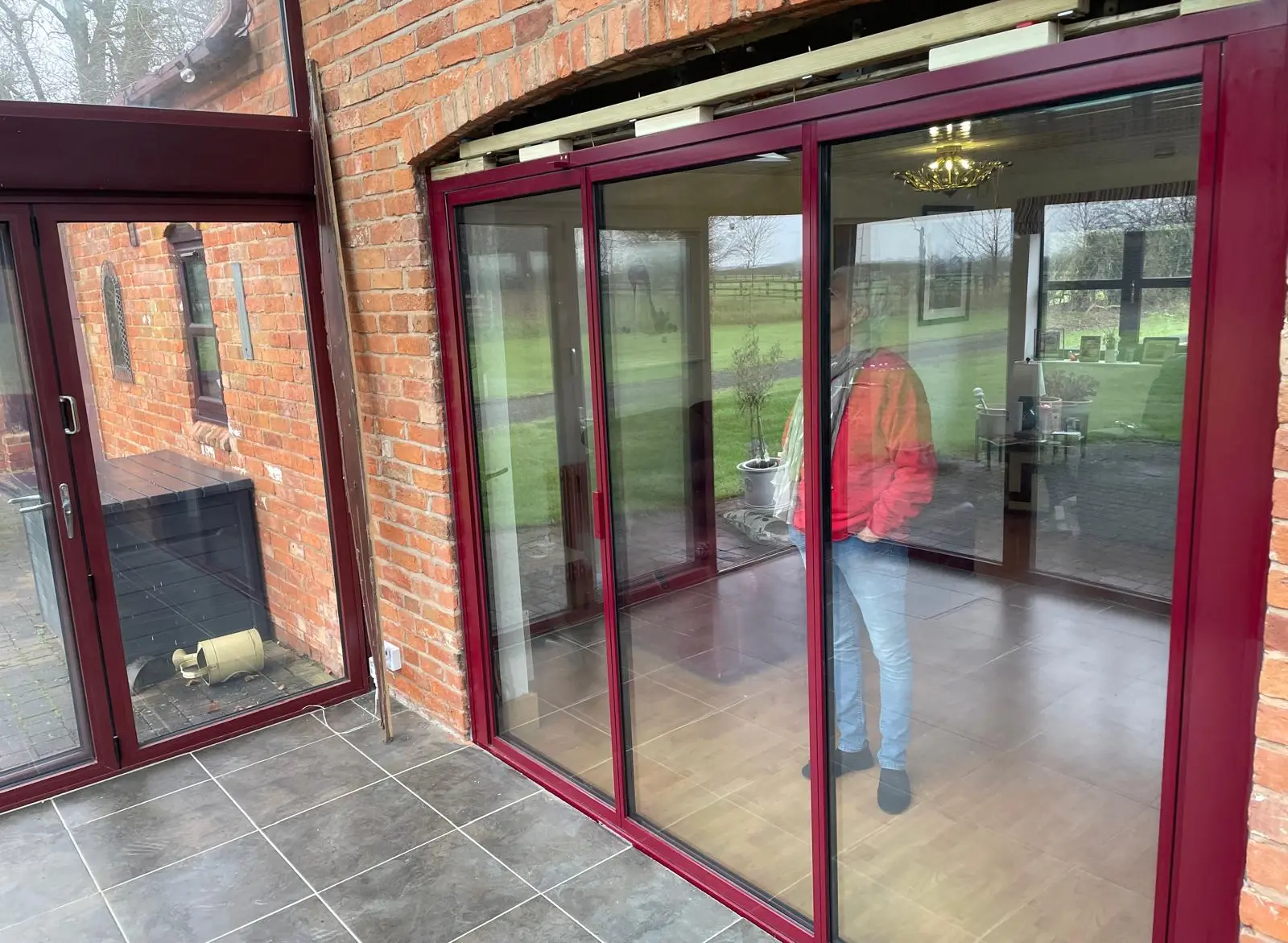
How Powder Coating Works
Raw aluminium frames undergo thorough preparation before coating begins. This includes cleaning, chemical pre-treatment, and chromate conversion to ensure proper adhesion.
The powder coating process uses electrostatically charged particles that stick evenly to the frame surface before heating in special ovens, where the powder melts and flows to create a uniform finish.
Unlike wet paint, powder coating doesn’t run or drip during application. The process produces thicker, more consistent coverage than traditional painting methods.
Aluminium concertina doors treated this way resist chipping, peeling, and fading far better than painted surfaces, maintaining their appearance for decades with minimal maintenance.
Colour Options and Trends
Modern powder coating technology offers hundreds of colour choices for aluminium concertina glass doors. Popular options include anthracite grey, black, and white, though manufacturers now provide extensive RAL colour ranges. Coloured bifold doors can match existing windows or create striking contrasts with surrounding materials.
Textured finishes provide additional design possibilities, from subtle grain effects to metallic sheens. These specialised coatings add visual interest while helping to hide minor scratches or marks that might occur through daily use. Some textures also offer improved grip on handle areas.
Dual Colour Options
Many homeowners choose different colours for interior and exterior surfaces of aluminium concertina doors. This dual-colour approach allows the outside to complement external brickwork or cladding while the inside matches internal colour schemes. The powder coating process makes such combinations possible without compromising durability on either side.
Weather Protection
The chemical bonding between powder coating and aluminium creates exceptional weather resistance. Salt spray testing shows properly coated frames withstand coastal conditions without deterioration. The coating prevents oxidation and corrosion that might otherwise occur when raw aluminium faces harsh weather.
Powder coating thickness typically ranges between 60 and 120 microns – far thicker than standard paint finishes. This depth of coverage provides robust protection against UV rays, preventing colour fade even in direct sunlight. The coating also resists damage from cleaning chemicals, making maintenance straightforward without risking the finish.
Marine-grade powder coating offers extra protection for coastal locations where salt air poses additional challenges. These specialised coatings contain additives that provide superior resistance to salt spray and chemical exposure. While standard powder coating works well for most locations, properties within a few miles of the coast benefit from this upgraded protection.
Quality manufacturers back their powder coating with lengthy guarantees, often 25 years or more. These warranties cover colour stability, adhesion, and resistance to peeling or flaking. Regular cleaning with mild soap and water maintains the coating’s protective properties and appearance, while avoiding abrasive cleaners prevents damage to the finish.
About SunSeeker Doors
With over 20 years of experience, SunSeeker Doors remains at the forefront of door design with our quality-tested patio doors and related products, including the bespoke UltraSlim aluminium slide and pivot door system, Frameless Glass Doors, and Slimline Sliding Glass Doors. All of our doors are suitable for both internal and external use.
To request a free quotation, please use our online form. You may also contact 01582 492730, or email info@sunseekerdoors.co.uk if you have any questions.


